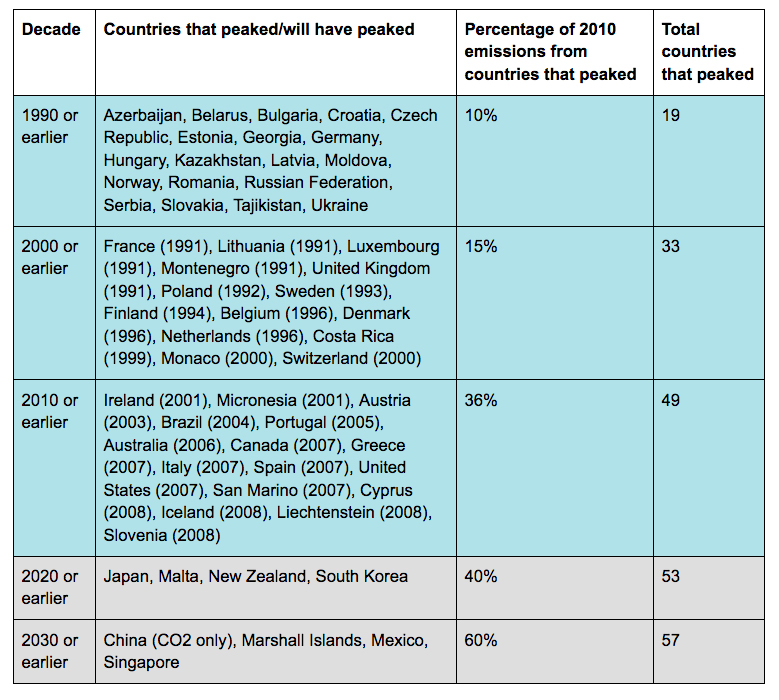
Analysis: WRI data suggests emissions have already ‘peaked’ in 49 countries
Multiple Authors
11.02.17Multiple Authors
02.11.2017 | 1:00pmTo avoid dangerous levels of global warming, the international community has pledged to limit global temperature rise to less than 2C above pre-industrial levels.
This commitment requires rapid and sustained reductions in greenhouse gas (GHG) emissions over the next few decades from all of the world’s major emitters. To meet this target, global emissions would likely have to peak in the next few years and decline 50% by the year 2050, according to the latest United Nations analysis.
A new report published by World Resources Institute (WRI), a US-based global environmental research group, now suggests that 49 countries have already seen their emissions peak, representing around 36% of current global emissions. Another 8 countries representing another 23% of emissions have commitments to peak in the next decade or so.
Turning points
Using WRI’s data, Carbon Brief has created the interactive chart below. It shows the countries whose emissions have peaked in each decade, with the size of the bubble representing the relative size of that country’s emissions. The line at the bottom shows the percent of current global emissions represented by the peaking countries.
When national emissions peaked
Determining when a country has peaked is not always straightforward. While emissions may be flat or decline for a few years, it is no guarantee that they may not tick back up in the future. In creating their list of countries that have peaked, WRI has looked both at the emission history of the country and its domestic policies and international commitments.
For example, while China’s energy-related CO2 emissions have declined slightly in both 2015 and 2016, it is too early to say whether emissions have actually peaked. China has committed to peak its emissions by 2030 and many experts expect it will happen before then, but the exact date is still unclear.
WRI’s analysis only considers countries with unconditional targets or pledges among those that have commitments to peak emissions in the future. Some countries have conditional targets that imply an emissions peak by 2030, such as Bhutan, Botswana, Ethiopia, Grenada and South Africa.
![]()
However, these commitments are only binding if international support is provided, which may not come to pass. So they are not included in the list of countries that have committed to peak by 2020 or 2030.
The interactive map below shows the GHG emissions peak date for different countries around the world, with countries in grey having no definite peak date or planned peak date. Clicking on a country on the map will show its emissions (in million tonnes CO2-equivalent) between 1990 and 2015, when available.
Greenhouse gas emission peak dates and country-level emissions. Click on individual countries to see their emissions over time. Peak dates based on the WRI Turning Points report. Country emissions from 1990-2015 based on date from PIK and UNFCCC. Chart by Carbon Brief using Highcharts.In 1990, 19 countries had already peaked their emissions, according to WRI’s analysis. Many of these were part of the Soviet Union, whose breakup subsequently led to economic crisis and large changes in industrial activity that dramatically reduced emissions in many former Soviet countries. Germany’s emission reductions also benefitted from a restructuring of the economy in the former East Germany post-reunification.
By 2000, 33 countries had peaked emissions, including the UK, France, Poland, Sweden, Switzerland and the Netherlands. Costa Rica’s emissions also peaked, making it the first country to do so outside of Europe and the former Soviet Union. These countries collectively represent 15% of total global GHG emissions.
By 2010, a number of additional countries in the Americas had seen their emissions peak, including the US, Canada, and Brazil. Australia and Micronesia also joined the group, as well as more European countries, such as Ireland, Austria, Portugal, Greece and Spain. In 2010, countries who had peaked their emissions represented a combined 36% of total global emissions.
By 2020, Japan, New Zealand and South Korea have committed to peak. And by 2030 (or potentially earlier) they will likely be joined by China (for CO2 emissions), Mexico and Singapore. By 2030, countries representing at least 60% of global emissions are committed to reach their respective peaks.

List of countries that peaked or have a commitment to peak and the percentage of global emissions covered, by decade. Table adapted from WRI Turning Points report. Note that unlike the table in the WRI report, the percent of global emissions in countries that peaked is shown relative to 2010 rather than to the decade in which the peak occurred.
Global emissions must peak soon
The news that 49 countries have already peaked their emissions is a sign that the world is moving away from a business-as-usual scenario where global average temperatures reach 4C or more above pre-industrial levels by the end of this century. Global CO2 emissions from energy were largely unchanged in 2016 relative to 2015, raising hopes that a global peak in emissions may be possible in the near future.
If countries stick to existing commitments to peak and reduce emissions, but undertake few additional reductions, global emissions would stay relatively flat through to 2100 and the world would warm around 3C. While this could help avert some of the worst impacts of high-end warming scenarios, it would still be far away from delivering the 2C goal embraced by the international community.
Carbon Brief reached out to researchers at Norway’s Center for International Climate Research (CICERO) to examine how the timing of a global emissions peak affects the required speed of future reductions. The figure below shows a number of different CO2 emission reduction curves that have a 66% chance to keep warming below 2C. It shows how the later global emissions start to decline, the more rapid the subsequent emission reduction needs to be.
Emission reduction trajectories associated with a 66% chance of avoiding more than 2C warming by starting year. Solid black line shows historical emissions, while dashed black line shows emissions constant at 2016 levels. Data and chart design from Robbie Andrew at CICERO and the Global Carbon Project. Chart by Carbon Brief using Highcharts.To have a good chance of avoiding 2C warming, global emissions need to peak some time in the next few years and decline very rapidly thereafter. If global emissions had peaked around the year 2000, it would have been possible to gradually reduce emissions by only 1-3% per year and still avoid 2C warming. In 2016, however, a sizable portion of the remaining carbon budget had already been used up.
If global emissions peak in 2017, they need to decline by 4-8% per year. If the world waits until 2025 to start reducing emissions, reductions would have to be a massive 8% or more per year.
It’s worth noting that these emission reduction scenarios do not include negative emissions, which involve removing CO2 from the atmosphere through options such as bioenergy with carbon capture and storage, aforestation, and land management changes. These could potentially buy more time to avoid 2C warming (or to overshoot, then draw CO2 levels back down), but are largely untested at scale.
Conclusions
Countries representing around 36% of global emissions have already peaked. Others, including China, may peak their emissions in the near future. In total, 60% of current global emissions are in countries that have or will soon have emissions peak. This raises hopes that some of the worst potential warming scenarios might be avoided. However, it is only a first step toward the large reductions in global emissions needed to avoid 2C warming.
Global emissions will likely need to peak in the next few years if there is to be a reasonable chance for limiting global warming to 2C. Rapid emission reductions will be needed thereafter, with an increasingly assumed reliance on as-yet-untested negative emissions technologies the longer that the world delays.
-
Analysis: WRI data suggests emissions have already ‘peaked’ in 49 countries

